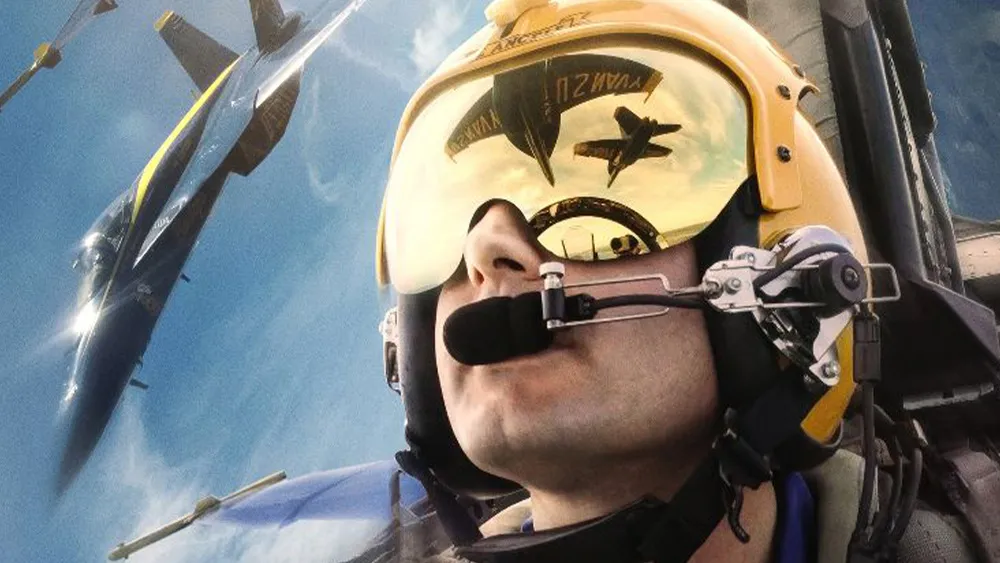The Blue Angels Review

By chronicling the activities of an aviation organization established by the US Navy across a season of demonstrations, Paul Crowder’s “The Blue Angels” is arguably one of Hollywood’s most glowing examples of what may be called military propaganda – films that celebrate American servicepeople in uniform.
The best Army film since ‘Top Gun’? Maybe. It comes with all the standard disclaimers: If you love America; if you love our men and women in uniform; if you love our fighting forces and everything they do, then ‘Blue Angels’ is for you. But it feels like Crowder (or someone) put some thought into it this time because he chose a group that performs a service that is itself public relations and does not involve any operations on the battlefield.
This movie is about excellence within an organization, not necessarily Maverick individuals out to break all the rules like Pete Mitchell. Its about Top Guns who know how to follow orders…mostly.
“The Blue Angels,” framed by each day’s schedule, from sunup briefings through after-action debriefs until sundown maintenance checks often conducted at an airport near you! shows us all those things: precision, resilience, teamwork. And also: leadership.
Crowder takes his cue from ‘Top Gun,’ opening with a recitation of the Blue Angels’ Creed before cutting to Boss Kesselring (fleetingly known as Brian), their flight leader for 2022, in a briefing room where he runs through a breakdown of the environmental conditions they’ll be flying in using piloting shorthand so fast it sounds like he’s trying to create drag on his own words. It’s only the first day of prep for the season but we’re already late for everything; we get our bearings while keeping pace with Kapuschansky and Goossens due east on I-10 so we can understand how urgently disoriented everyone must feel around here.
Kesselring is a focused, intense presence in medium closeup as he looks directly into the camera, establishing clear-eyed authority with his gaze if you don’t lean back a little in your seat when he’s talking to you, you’re probably not wearing one. He speaks with calm urgency about what needs to be done and why it matters; we believe him and want to help.
And finally: flight. Although this is an IMAX movie that will make your stomach drop into your shoes periodically for no reason at all other than frightful height and velocity, the aerial sequences are also educational. They’re like those magic-eye puzzles that reveal a second image within the first if you just look long enough without blinking or breathing or thinking too hard about why anyone would create such a thing as a magic-eye puzzle.
Here is what I learned from ‘The Blue Angels,’ which is not so much a performance piece as it is an instructional video for pilots who already know how to fly four planes 18 inches from one another at 400 mph in a perfect diamond shape while doing corkscrews and extreme barrel rolls:
First-person perspectives from each pilot did not make me feel like I was flying in any particular plane of my own.
But they did make me feel like I was looking up (way up) at an aircraft with ‘US NAVY’ painted on its underside while trying to align the yellow paint on the wings of two other planes below it.
Also: helicopters should avoid getting too close to jet engines while they’re running, unless everyone involved has agreed ahead of time that this will be part of the show.
The footage shot inside each cockpit makes everything altitude, G-forces, risk seem both more real and less urgent than I think it actually is. But I don’t know anything about aviation except what ‘Top Gun’ taught me (which isn’t much) so maybe this is how flying feels when you’re really good at it.
Finally the tour begins and Crowder can demonstrate how many people and pieces of equipment it takes to move the Angels between dozens of cities a year — from their unofficial home base in Pensacola, Fla., to Hawaii and back. It’s here that pilots talk about the personal cost of joining: 300 days per year away from family, even if spouses are in the military. Kesselring thinks of his time with the Angels as an opportunity to “give back,” but he knows it comes at a price.
Crowder also suggests that while they don’t have combat duties, there is risk involved for Angel pilots; he mentions Capt. Jeff Kuss, who died in 2016 after his jet crashed during practice for a show. This detour adds some shade to what is meant as an informational sometimes celebratory look at the group, building toward the final chapter where Kesselring picks his own replacement as flight leader (a rarity among Navy divisions), steps down from that role himself and selects new team members alongside another one-year-only leader who will serve with Armatas.
It’s also during these parts of “The Blue Angels” that Crowder provides greater context for or simply more choppiness to a military operation that appears designed primarily for showmanship. The Blue Angels may literally fly victory laps on behalf of the U.S. Navy (Kesselring notes that it’s 45 minutes “of pure violence”), but their squadron serves as a less blood-soaked version of combat footage: another reason for any viewer who hasn’t attended a Blue Angels event to do so when they come back around (or visit their YouTube page), offering an intimate look at maneuvers complete with slow motion and angles civilians never see; all done by men and women those same civilians often take for granted.
The turn against humanity is quick, though: We see Kapuchansky, then Goossens suffer, and then Lee pass out alongside new flight leader Alexander Armatas in a G-force simulator during orientation.
Watch The Blue Angels For Free On Gomovies.
.jpg?w=1024&resize=1024,1024&ssl=1)
.jpg?w=1024&resize=1024,1024&ssl=1)
.jpg?w=1024&resize=1024,1024&ssl=1)
.jpg?w=1024&resize=1024,1024&ssl=1)
.webp?w=1024&resize=1024,1024&ssl=1)
.jpg?w=1024&resize=1024,1024&ssl=1)
.jpg?w=1024&resize=1024,1024&ssl=1)
.jpg?w=1024&resize=1024,1024&ssl=1)